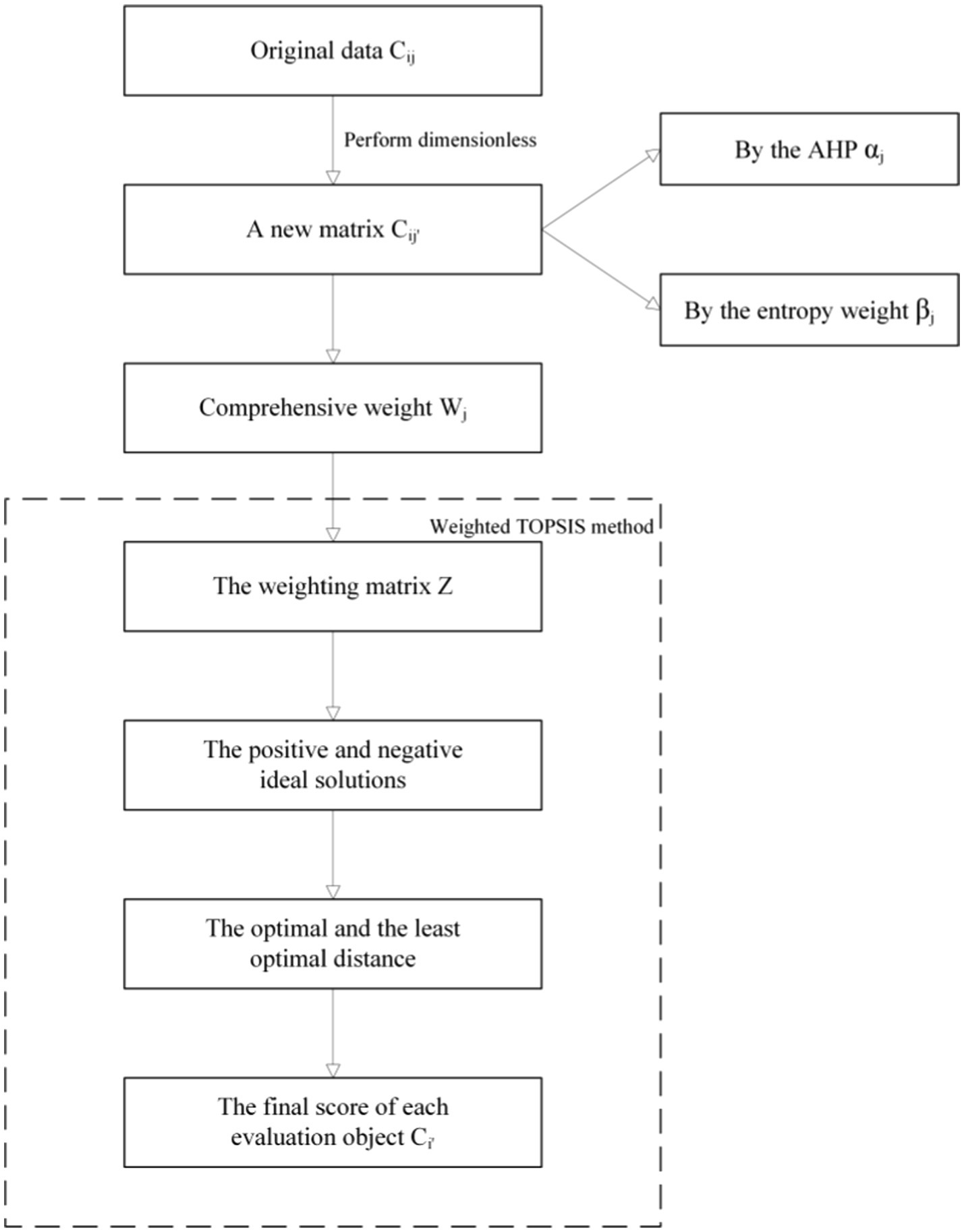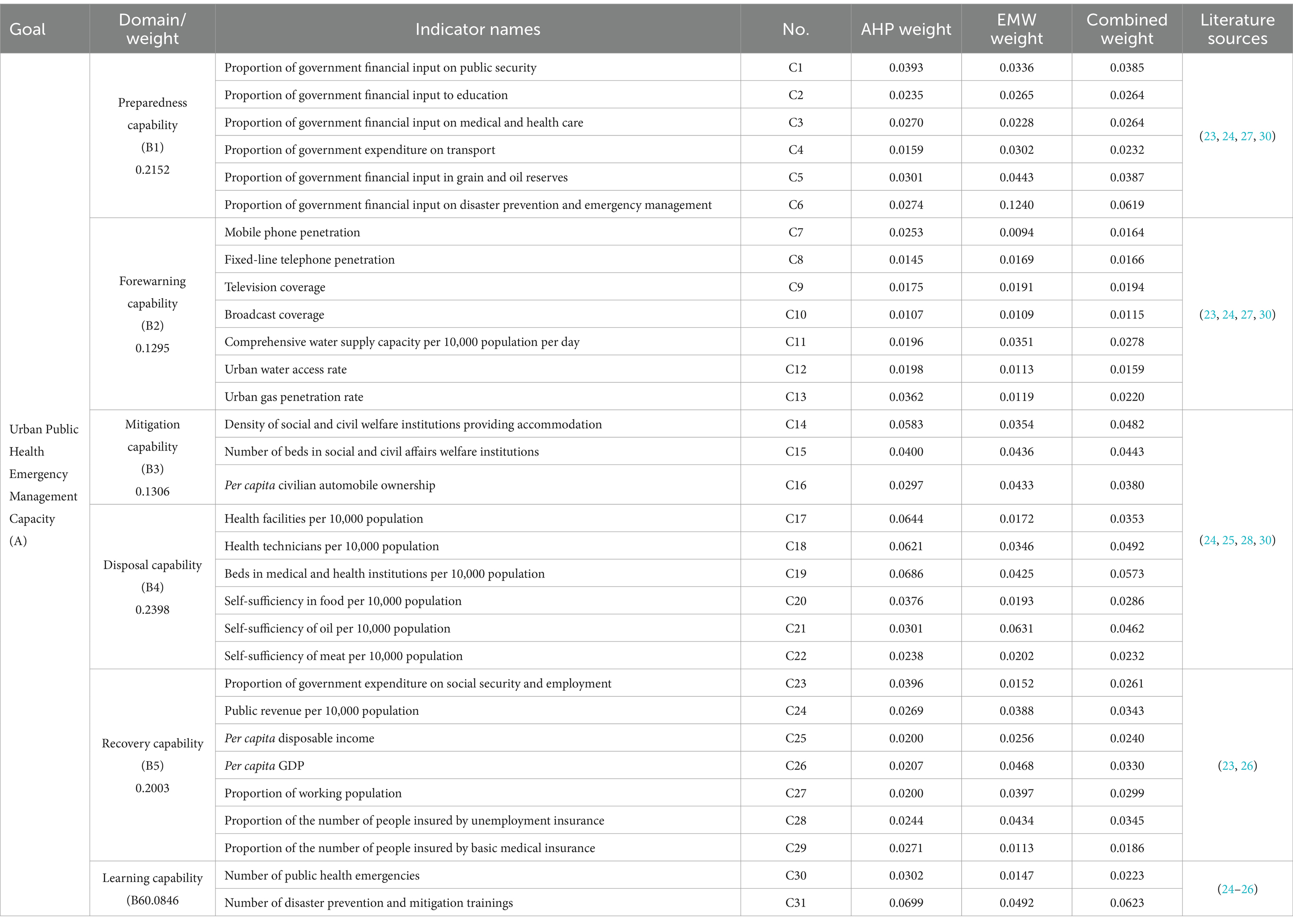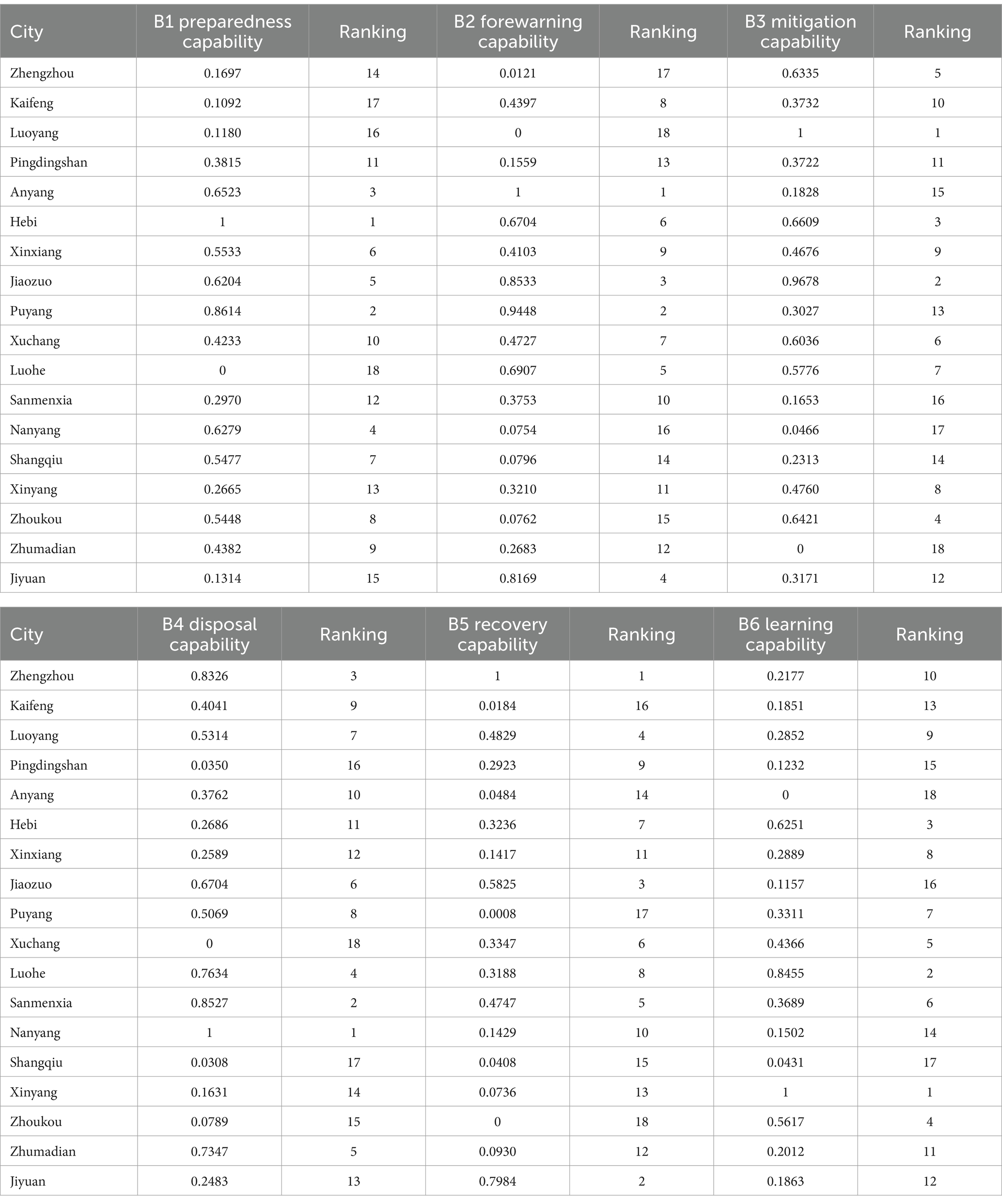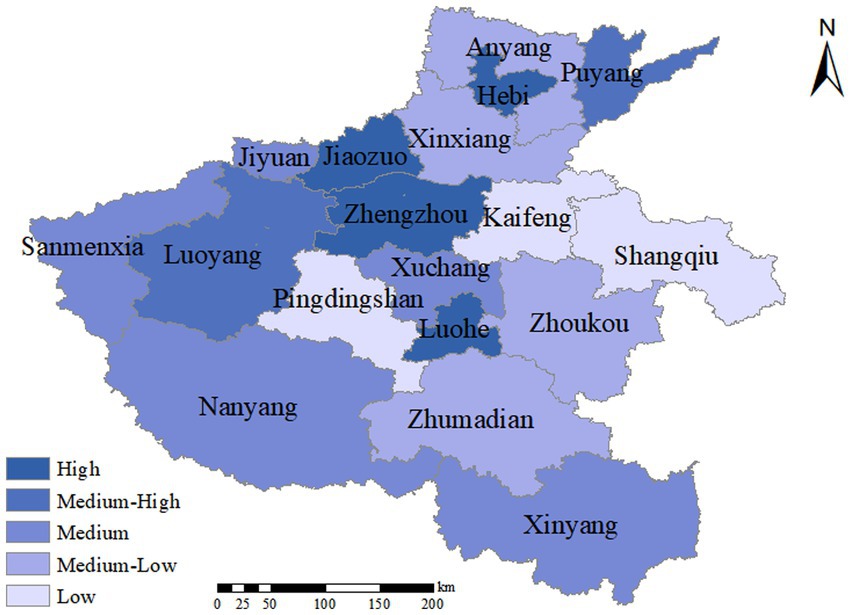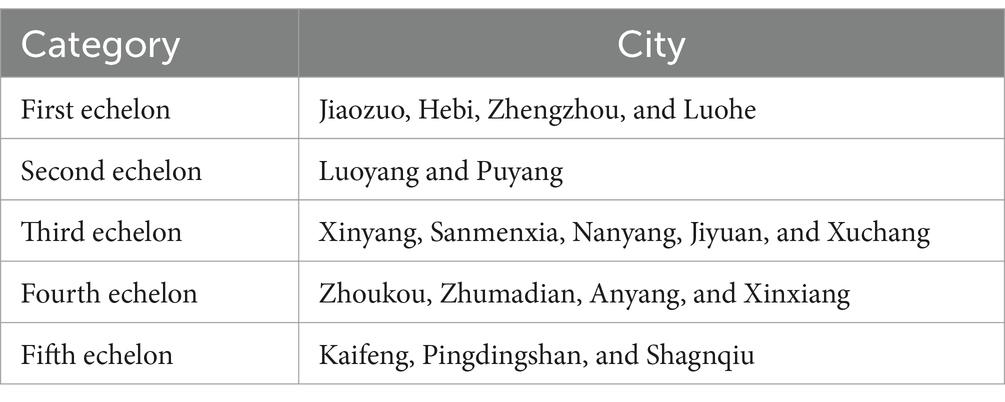- 1Safety and Emergency Management Research Center, Henan Polytechnic University, Jiaozuo, China
- 2Laboratory of Emergency Management, Henan Polytechnic University, Jiaozuo, China
- 3School of Information Management, Central China Normal University, Wuhan, China
With the rapid development of the economy and society, the likelihood of sudden public health emergencies in urban areas continues to rise. In particular, major infectious diseases that have gained global attention, such as the SARS virus, H1N1 influenza, Ebola outbreak, and COVID-19 pandemic, have presented significant challenges to urban emergency management systems. Evaluating emergency management capability is a fundamental requirement for developing emergency response capacity. To this end, this study combines the theory of resilience with the theory of full-process equilibrium emergency management, selects 31 evaluation indicators from six key aspects: preparedness, forewarning, mitigation, disposal, recovery, and learning. The indicator weights are determined using the AHP-Entropy Weight Method, and a TOPSIS model is constructed to assess the emergency management capability of urban public health emergencies. The model’s applicability is validated by examining 18 cities in Henan Province. The findings suggest that Jiaozuo, Hebi, Zhengzhou, and Luohe possess relatively robust emergency management capabilities for sudden public health incidents, whereas Kaifeng, Pingdingshan, and Shangqiu exhibit weaker capabilities.
1 Introduction
The public security situation has become increasingly severe with the rapid development of China’s economy and society. A series of sudden public health emergencies, including SARS, H1N1 influenza, and the COVID-19 pandemic, have emerged one after another (1). These crises not only pose a severe threat to the life and health of the population but also impact economic development, social stability, and political security. Additionally, they present a significant challenge to the emergency management capabilities of urban areas. The emergence of COVID-19, a novel coronavirus causing pneumonia, was sudden at the end of 2019. Its rapid spread prompted the World Health Organization (WHO) to declare it a Public Health Emergency of International Concern (PHEIC) in January 2020 (2). COVID-19 is the most severe global pandemic of infectious diseases in a century (3). It presents the most challenging public health emergency in China since the founding of the People’s Republic due to its rapid and difficult-to-control spread (4).
At present, China is in the period of social transformation, which is an important period to improve the public health emergency response system and consolidate the emergency response capacity in an all-round way. Emergencies refer to natural disasters, accident disasters, public health events and social security events that occur suddenly, cause or may cause serious social harm and need to be dealt with by emergency measures (5). The public health emergencies studied in this paper are characterized by the inability to measure with tools, the difficulty to judge the signs of its occurrence before it occurs, and the rapid outbreak, wide radiation and will have a bad impact on the urban economic and social order, which also poses a challenge to the construction of resilient cities. Therefore, improving the emergency management ability of urban public emergencies is the only way to improve the urban comprehensive emergency system and capacity modernization (6), and it is also an important pillar of the construction and development of resilient cities (7).
Throughout the emergency management process, any critical step overlooked or any present loophole can result in serious errors, leading to irreparable loss of life, property, and social disorder. This sensitivity requires balance throughout the entire process. In 2020, Professor Zhang (8) proposed a new issue of balanced emergency management for the full process mechanism in China, addressing the imbalance problem. He suggests that “the full process balance of emergency management” in China includes six hierarchical mechanisms and one cross-stage mechanism, refining emergency management, risk management, and crisis management into preparation and response, prevention and mitigation, recovery and learning, with monitoring running through the entire emergency management process, as illustrated in Figure 1.
Therefore, from the perspective of the whole process equilibrium of emergency management, this paper constructs the evaluation index system of emergency management ability of urban public health emergencies, and uses TOPSIS method to evaluate the level of urban emergency management, which provides qualitative evaluation basis for the government to make emergency management decisions. In addition, it also puts forward operational countermeasures and suggestions for the emergency management ability of cities in response to public health emergencies, aiming at providing policy suggestions for the development of urban emergency management.
2 Literature review
In 1997, the Federal Emergency Management Agency (FEMA) and the National Emergency Management Association (NEMA) conducted research. They released the Capability Assessment for Readiness (CAR) framework to evaluate the disaster preparedness of states and localities. This framework comprised 13 primary indicators, 203 secondary indicators, and 1,014 tertiary indicators (9). In the year 2000, the United States refined, improved, and revised this evaluation system (10). Since the terrorist attacks 9/11, the field of emergency management has rapidly developed and established its system in both practice and research, leading to a significant increase in the evaluation of emergency management capabilities. Japan has collaborated with government agencies to establish a collaborative disaster prevention capability evaluation system, which includes indicators for crisis assessment, disaster management, material support, and information communication to evaluate regional disaster prevention capabilities (11).
Regarding theoretical research, Miguel (12) employed the Fuzzy Analytic Hierarchy Process (FAHP) to identify performance evaluation indicators for emergency decision-making in emergency management departments. He developed a multi-criteria decision model (MCDM) to enhance public emergency decision-making and response capabilities. Guofeng (13) proposed a Capability Maturity Model (FE-CMM) for building fire emergency management, which is based on building fire threats and integrated with the fire control center to achieve pre-control and exemplary management of building fires. Arleiny (14) conducted qualitative research to analyze the causes of fire disasters in Indonesia and evaluated the search and rescue capabilities of different regions in the event of fire disasters through case studies.
Although China’s research on evaluating emergency management capabilities for sudden events started relatively late, it has accumulated a wealth of research results. Cheng et al. (15) developed a comprehensive city emergency management capability evaluation system from a safety development perspective, utilizing a combination of the matter-element extension model and cloud model. Chuai et al. (16) determined indicator weights through the AHP-entropy method and constructed a disaster emergency capability evaluation model to assess seven geographical regions, 31 provinces, and 339 cities in China. Jia et al. (17), Ming et al. (18), Liu et al. (19), and Huang et al. (20) conducted detailed evaluations of earthquake emergency capabilities in the island, Hainan, Xinjiang, and Guangdong regions, respectively.
International research on evaluating emergency management capacity for sudden events is still in its infancy and needs a robust theoretical framework. The United States has taken the lead in early evaluations of emergency management capacity for sudden events worldwide, and its comprehensive evaluation index system serves as a reference for many countries researching emergency management capacity evaluation. While there have been numerous research achievements on evaluating emergency management capacity for sudden events both domestically and internationally, they have primarily focused on natural disasters or safety accidents, with a heavy emphasis on single natural disaster events or single disposal stages such as hazardous chemicals, earthquakes, and floods. There need to be more relevant evaluation studies on sudden public health events, with most studies focusing on the past two years and still in the preliminary stages. The research on evaluating emergency management capacity for the entire process of sudden events is relatively scarce and urgently requires improvement. Based on this, this paper uses subjective analytic hierarchy process, objective entropy weight method and TOPSIS method to process the data, evaluates the emergency management ability of urban public health emergencies in 18 cities of Henan Province, and puts forward countermeasures and suggestions to improve the emergency management ability, in order to provide qualitative evaluation tools for the government to carry out emergency management efficiently and immediately.
3 Building a public health emergency in the city emergency management capacity evaluation model
By constructing an evaluation model for the emergency management capability of urban public health emergencies, this study utilizes the TOPSIS method to compute the scores of the evaluation objects. In calculating the comprehensive weights of the evaluation indicators, a combination of the Analytic Hierarchy Process (AHP) and entropy weight method is employed. AHP and the entropy weight method represent subjective and objective weighting approaches, respectively. The weights obtained through subjective weighting methods are influenced by human subjectivity, while objective methods may fail to accurately reflect the evaluator’s emphasis on different indicators, potentially leading to discrepancies with the actual conditions. Consequently, this study adopts a combined approach of AHP and entropy weighting, effectively addressing the subjective biases introduced by human factors and the objective shortcomings of overlooking indicator characteristics, thereby resulting in a more scientifically rational assignment of indicator weights. The computational flowchart for the evaluation model is illustrated in Figure 2.
3.1 The setting of the index system
Urban resilience is the ability of cities to quickly return to normal operation after responding to emergencies. It is the proper meaning of building a holistic urban safety system, and urban public health event response capacity building is an important part of it (21). This paper adheres to the focus of resilient urban development. In order to comprehensively enhance the city’s ability to cope with the complex social risks brought by public emergencies (22), based on the “6 + 1” model of the whole process equilibrium theory of emergency management, the emergency management ability of urban public health emergencies is divided into six aspects: preparation ability, early warning ability, mitigation ability, disposal ability, recovery ability and learning ability. Among them, the ‘monitoring’ stage in the whole process equilibrium theory of emergency management should not be regarded as a stage alone because it involves many key links, even the whole process of emergency management. Therefore, we can build a truly safe and reliable ‘resilient city ‘with more refinement and specialization.
The selection of evaluation indicators follows the principles of indicator independence, scientificity, and data availability and draws on relevant research results (23–30). In light of the current COVID-19 epidemic situation in China, and fully considering the capacity requirements of resilient city construction, using the Delphi expert method to screen the indicators, members of the Ministry of Emergency Management’s think tank were selected as experts to score the selected evaluation indicators, and, based on the scoring, the mean value of the scores of the indicators was calculated, and the indicators with an importance level of 4.0 or less were removed. A corresponding evaluation indicator system is constructed based on this framework, as shown in Table 1.
3.2 Calculation of evaluation model
3.2.1 The original matrix of dimensionless data is established
Based on the original data, the spatial matrix C comprises n cities and m indexes.
Next, the standardization of data processing.
Positive indicators:
Negative indicator:
Getting a new matrix:
3.2.2 Determine the comprehensive weight of evaluation indicators
The Analytic Hierarchy Process (AHP) and Entropy Weight Method (EWM) represent subjective and objective weighting methods. AHP determines indicator weights by comparing their relative importance on a 1–9 scale (31), while EWM quantifies indicator weights by calculating entropy values based on collected data (32, 33). The indicator weights obtained by subjective weighting methods are subject to human subjectivity. In contrast, objective weighting methods cannot reflect the evaluators’ degree of importance for different indicators, and may even result in opposite situations to the actual indicators. Therefore, this study adopts a combination of AHP-EWM to effectively address the subjective influence caused by human factors and the objective deficiency of ignoring indicator characteristics, thus making the indicator weight values more scientifically reasonable. Comprehensive weight calculation formula:
Where: is the weight calculated by the analytic hierarchy process; is the weight calculated by the entropy weight method.
3.2.3 Weighted TOPSIS method
The Technique for Order Preference by Similarity to Ideal Solution (TOPSIS) method is widely used for multi-objective analysis of final solutions in systems engineering, with applications in various fields. The method involves constructing a space based on a normalized initial data matrix, where the final solution’s positive and negative ideal solutions define the boundaries. The evaluated solution is represented as a point in this space, and its relative closeness to the ideal solutions is determined by calculating the distance between the point and the positive and negative ideal solutions. The quality of the solution is evaluated based on the size of the distance.
First, calculate the weighting matrix.
In the formula, is the standardized judgment matrix after translation, and is the final combined weight of each index.
Secondly, the positive and negative ideal solutions are calculated.
Positive ideal solution:
Negative ideal solution:
To get the optimal distance:
The least optimal distance:
After that, the relative closeness between each evaluation object and the ideal solution is calculated:
Finally, the evaluation results are standardized to obtain the final score of each evaluation object:
The evaluation result of the evaluation object can be divided into five levels according to the equal interval: high, medium-high, medium, medium-low, and low.
4 An empirical study and analysis of emergency management capability evaluation—a case study of Henan Province
4.1 Data source and data processing
The data for this article was originally sourced from the “2021 Statistical Yearbook” and “2021 National Economic and Social Development Statistical Bulletin” of 17 prefecture-level cities and one provincial-level administrative division (also known as a provincial-level county-level city) in Henan Province, as well as the official websites of the Henan Provincial Bureau of Statistics and various municipal statistical bureaus. The specific evaluation objects are listed in Table 2. The collected raw data underwent dimensionless processing, and the AHP-Entropy Weight Method was utilized to assign weights to the evaluation indicators, with weight results in Table 1. Finally, the TOPSIS method was employed to compare the relative closeness of each evaluation object to the ideal solution and obtain the evaluation value. The relative closeness and comprehensive evaluation ranking of the emergency management capacity of 18 evaluation objects in Henan Province for public health emergencies are displayed in Table 3. The evaluation values and rankings of the six primary indicators are presented in Table 4.
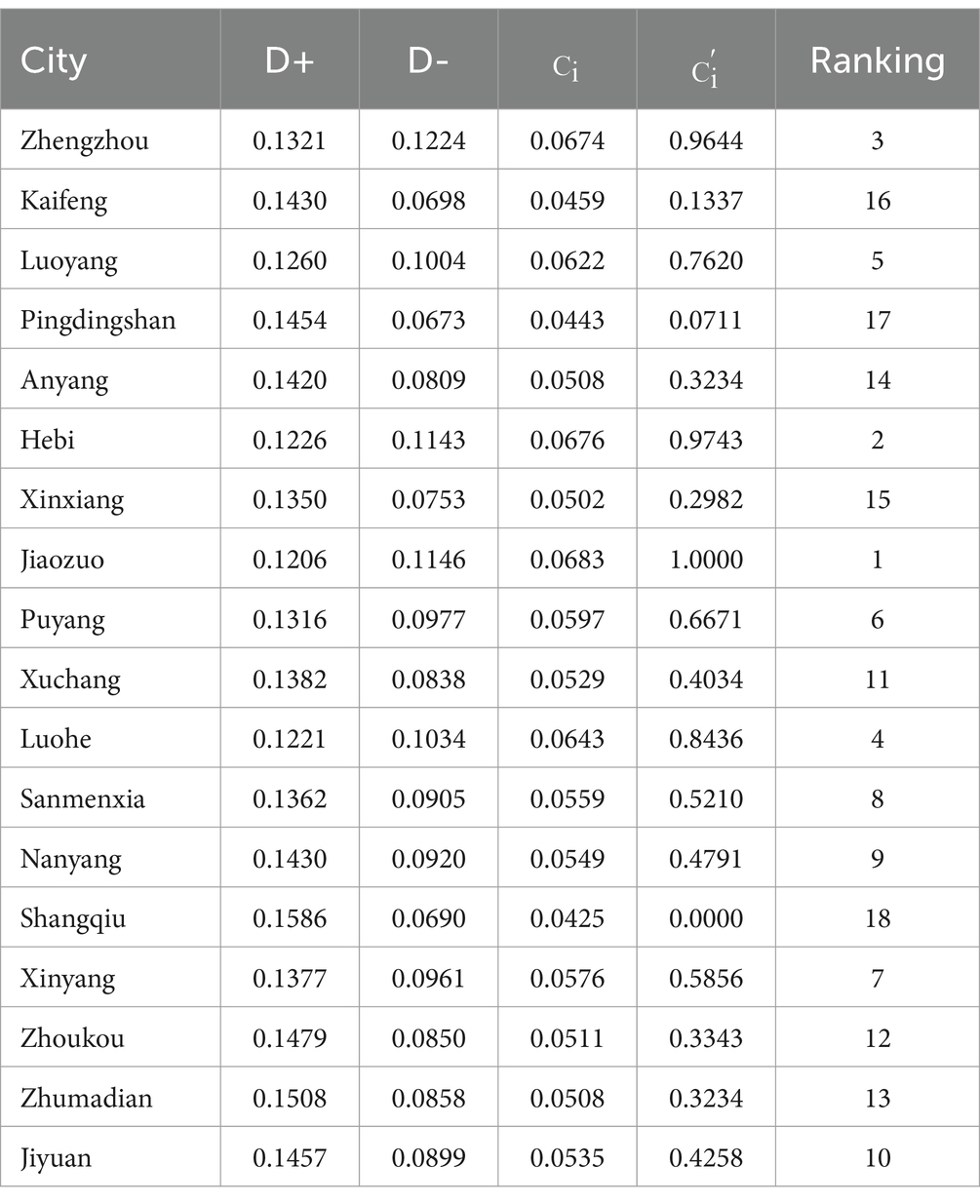
Table 3. Evaluation of comprehensive performance of public health emergency management capacity in Henan Province.
4.2 Analysis of emergency management ability of urban public health emergencies in Henan Province
As depicted in Figure 3, the emergency management capabilities of cities in Henan Province in response to sudden public health incidents can be classified into five levels based on their rankings, as presented in Table 5. The first tier, led by Jiaozuo City, exhibits a slightly higher level of medical infrastructure development compared to other cities of the same level within Henan Province. Additionally, a higher proportion of public safety expenditure in general public budget expenditures is also one of its significant influencing factors. Hebi City, Zhengzhou City, and Luohe City also belong to the first tier. Zhengzhou City, the provincial capital of Henan Province, has a large permanent population and is situated in a transportation hub position, with many population movements, making personnel management more challenging. However, the quality of medical care in Zhengzhou has improved in recent years due to the development of high-tech industries, digital management models, and urban logistics and social security. Moreover, Zhengzhou has a more vital ability to attract and accommodate talents. Nevertheless, the COVID-19 pandemic and the “7.20” major flood have significantly impacted Zhengzhou’s economic and management stability as the provincial capital city. Therefore, in the comprehensive evaluation, Zhengzhou’s relative closeness is greatly influenced by its pre-event preparation and event warning capabilities. Its emergency management capabilities for sudden public health incidents rank third in the province, following Jiaozuo city and Hebi city.
Hebi and Luohe cities have demonstrated exceptional preparedness, mitigation, and learning capabilities throughout the emergency management process for sudden public health incidents in Henan Province. This has been achieved through the establishment of comprehensive emergency plans, the construction of emergency command centers and material reserve centers, and the implementation of emergency drills and training measures. These efforts have provided robust support for responding to sudden public health incidents. By strengthening epidemic monitoring and early warning systems, timely isolation, investigation, and tracking measures have been implemented, effectively curbing the spread of the epidemic and reducing its risk. Through the timely identification of problems and the analysis of epidemic prevention and control work, valuable experiences have been accumulated, and emergency plans and response mechanisms have been continuously improved and enhanced. These efforts have laid a solid foundation for future responses to sudden public health incidents.
Based on the evaluation data, it is evident that the emergency management capacity for sudden public health incidents in most cities in Henan Province is concentrated in the third and fourth tiers. This phenomenon suggests substantial disparities in emergency management capacity for sudden public health incidents among cities in Henan Province, with over half of the cities requiring improvement in emergency management capacity. A holistic perspective reveals the urgent need to enhance emergency management capacity in these cities.
4.3 Evaluation and analysis of urban public health emergency management ability in 6 stages in Henan Province
4.3.1 Preparedness capability
Emergency preparedness refers to a city’s ability to proactively plan and allocate resources to minimize the impact of a public health emergency. Effective emergency preparedness involves careful consideration of potential scenarios and integrating and coordinating necessary resources. As illustrated in Figure 4, northern Henan Province exhibits a relatively high level of emergency preparedness, with Hebi, Puyang, Anyang, Nanyang, and Jiaozuo ranking at the forefront of public health emergency preparedness evaluations. This can be attributed to the significant government expenditure allocated towards public safety, medical and healthcare, disaster prevention, and emergency management within the general public budget.
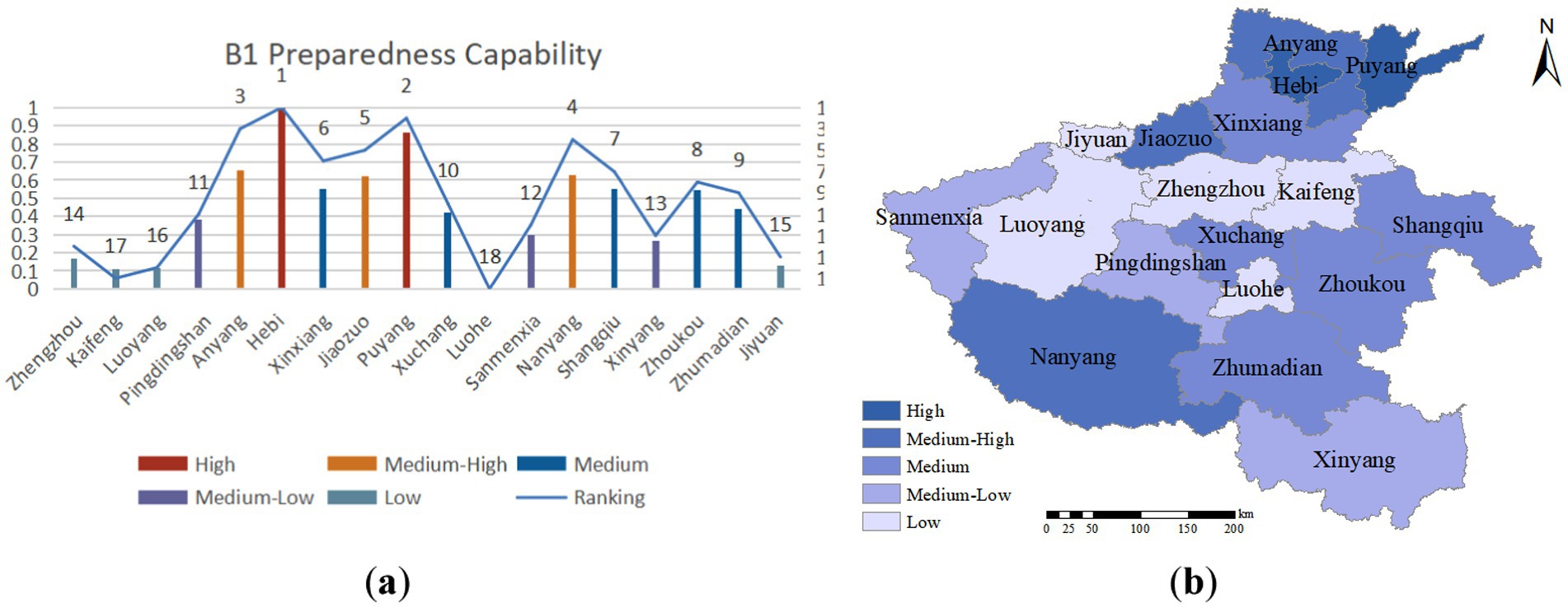
Figure 4. (A) Preparedness capability evaluation value and ranking; (B) preparedness capability assessment distribution.
4.3.2 Forewarning capability
The ability to issue emergency warnings involves predicting and alerting potential crises through various means and technologies before their occurrence, and promptly notifying relevant departments and personnel for emergency response, thereby minimizing harm and losses caused by emergencies. Warning capability is a critical component of emergency management for public health crises, and its accuracy and timeliness play a vital role in crisis resolution. As illustrated in Figure 5, the warning capability in the northern Henan region surpasses that of other areas, with Anyang, Puyang, and Jiaozuo ranking high in the evaluation. This is attributed to the region’s high communication penetration rate and extensive coverage of television and radio broadcasting.
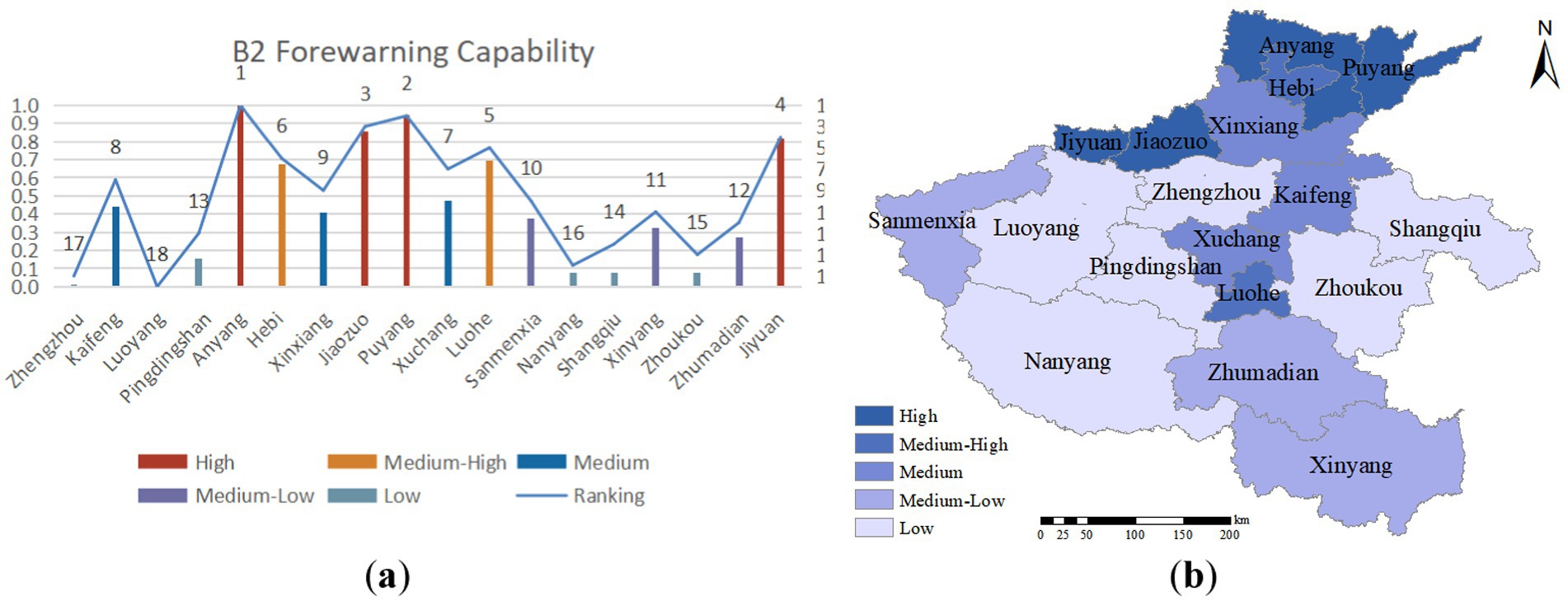
Figure 5. (A) Forewarning capability evaluation value and ranking; (B) forewarning capability assessment distribution.
4.3.3 Emergency capability
Emergency mitigation capacity is the ability to reduce or eliminate potential risks and hazards in an emergency. Urban healthcare systems can better respond to public health emergencies and minimize losses by mitigating risks. As depicted in Figure 6, the central region of Henan Province exhibits a relatively strong emergency mitigation capacity, while Zhoukou and Nanyang exhibit relatively weak capacities. Despite having many social welfare institutions providing accommodation, the large urban areas and high population densities of these two cities make it challenging for these institutions to effectively share the burden on the healthcare system during a public health emergency, resulting in a lower emergency mitigation capacity.
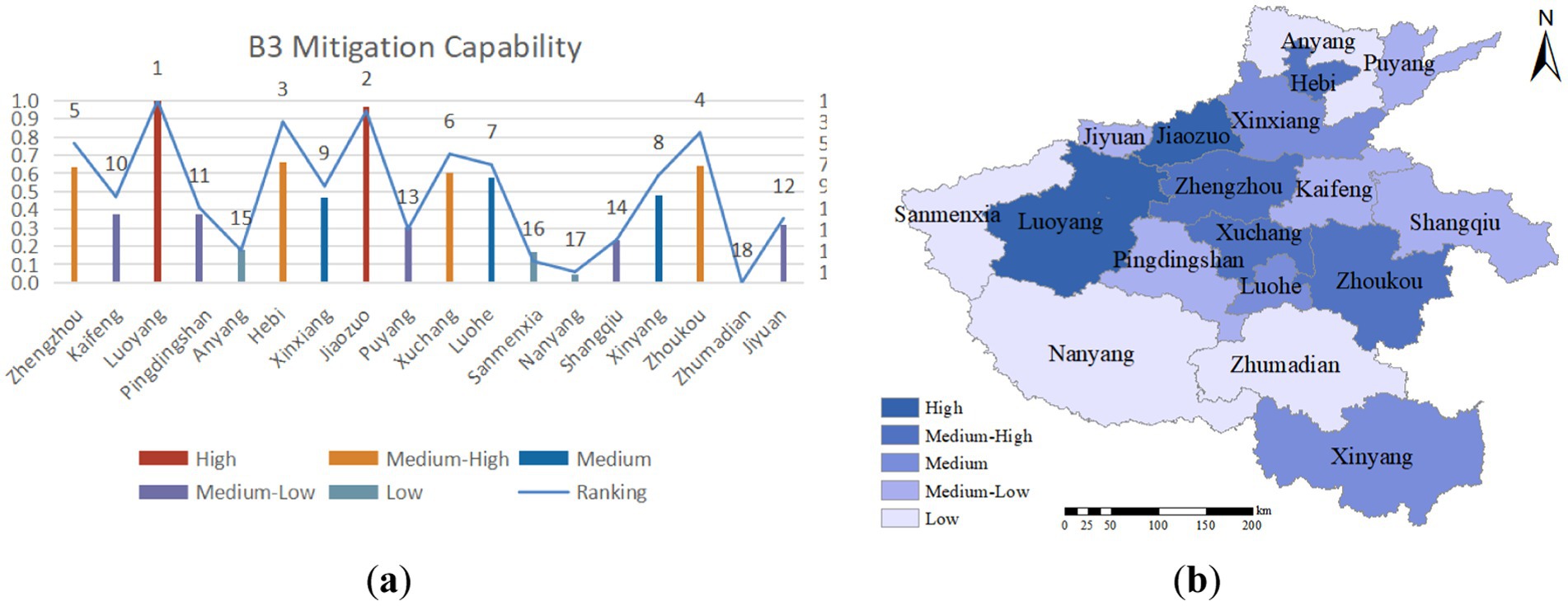
Figure 6. (A) Emergency capability evaluation value and ranking; (B) emergency capability assessment distribution.
4.3.4 Disposal capability
Emergency response capability is the capacity to promptly and effectively address and rescue individuals during emergencies or disasters. In an unexpected public health crisis, the medical and health standards per 10,000 individuals and the self-sufficiency of essential food items such as grain, oil, and meat can bolster a city’s ability to withstand such crises. As illustrated in Figure 7, urban areas in Henan Province exhibit a slightly higher overall emergency response capability, with Nanyang City serving as a significant population and grain hub in the province. Situated in a central region with convenient transportation, Nanyang City enjoys a strategic location advantage, connecting North China, East China, South China, and other regions, facilitating swift response and management of sudden public health emergencies.
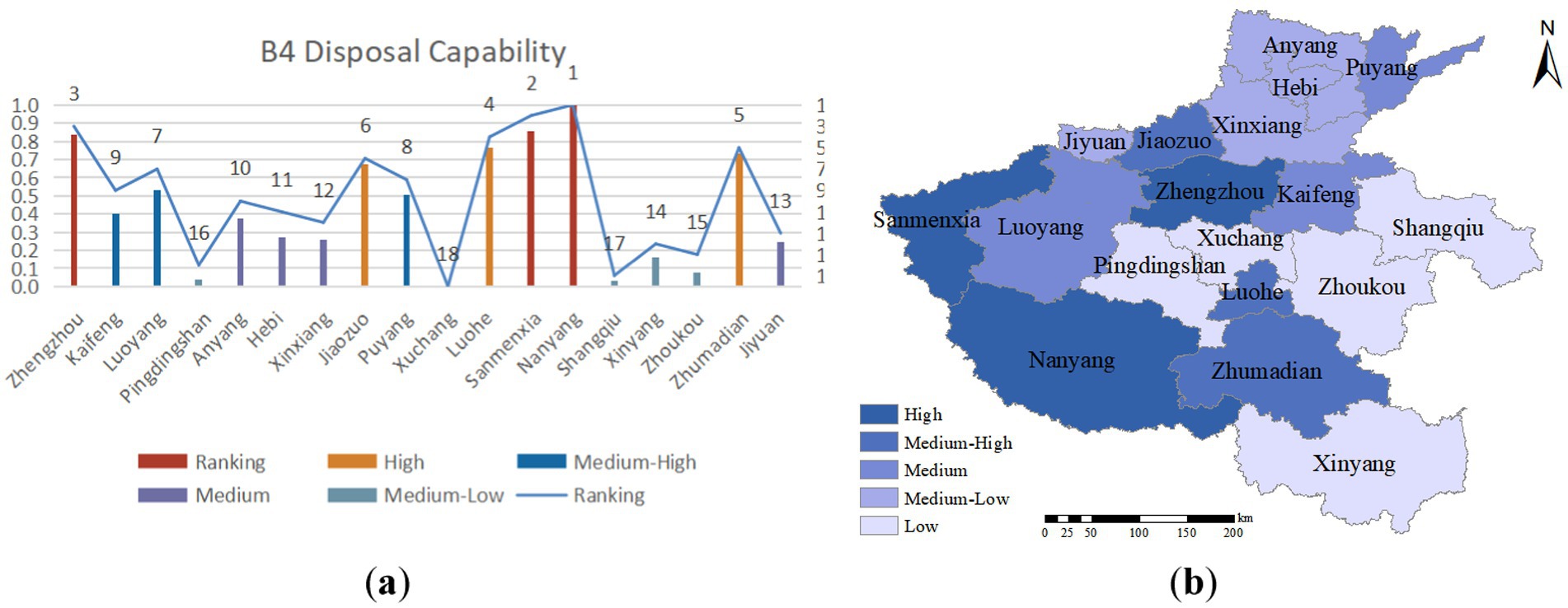
Figure 7. (A) Disposal capability evaluation value and ranking; (B) disposal capability assessment distribution.
4.3.5 Recovery capability
Emergency recovery capacity refers to the ability to restore normal social and economic activities swiftly and public order following a public health emergency through measures such as supporting economic reconstruction, ensuring social stability, and facilitating the resettlement of affected residents and businesses. As illustrated in Figure 8, the western and central regions of Henan Province exhibit more robust post-emergency recovery capabilities, followed by the southern part. At the same time, the eastern and northern areas display relatively weaker post-emergency recovery capabilities. The five cities with higher evaluation indices for this capacity are Zhengzhou, Jiyuan, Jiaozuo, Luoyang, and Sanmenxia, which benefit from higher government fiscal revenues, per capita disposable income, and per capita GDP, as well as a more significant proportion of primary medical insurance participation. These factors are key drivers of their more substantial post-emergency recovery capabilities.
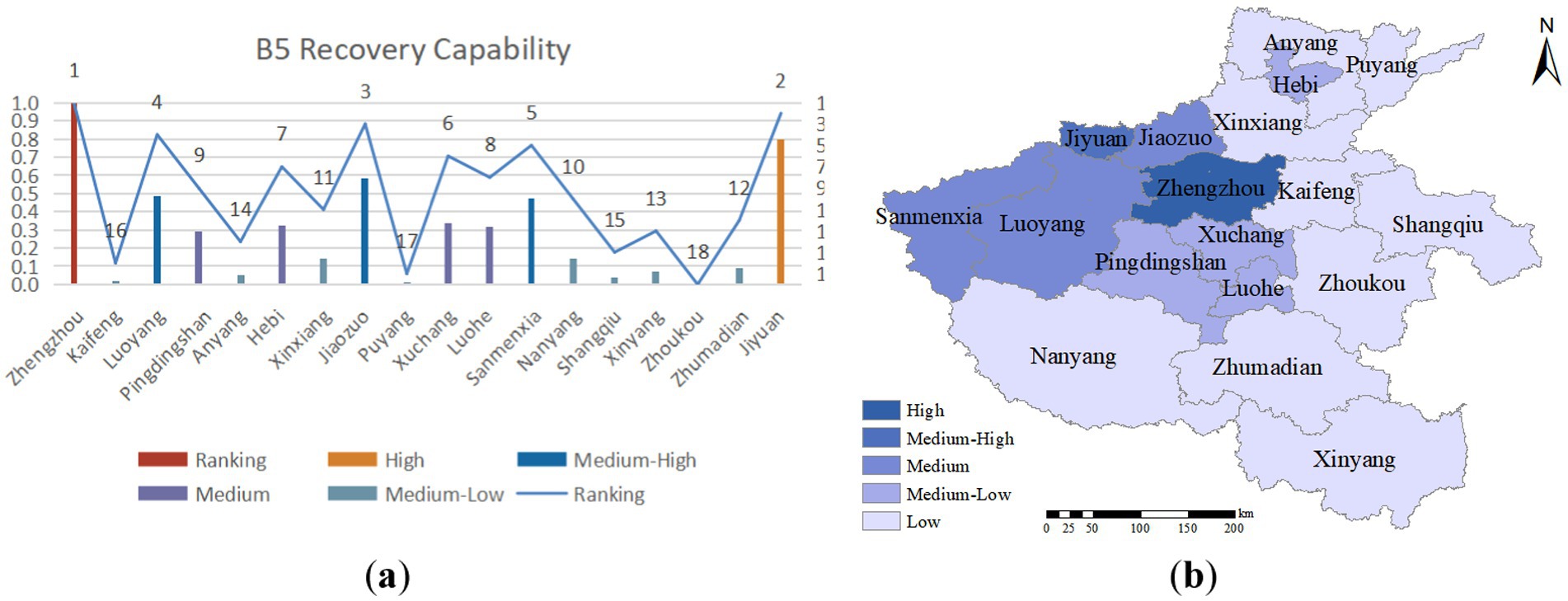
Figure 8. (A) Recovery capability evaluation value and ranking; (B) recovery capability assessment distribution.
4.3.6 Learning capability
The term “learning capability” refers to a city’s capacity to promptly and effectively conduct post-disaster summarization and learning, and to enhance its emergency response level through training and drills following public health emergencies. This metric is contingent upon two factors: the frequency of annual disaster prevention and reduction training, publicity, and drills and the frequency of public health emergencies that have occurred within the past five years. As illustrated in Figure 9, Xinyang, Luohe, and Hebi exhibit strong post-disaster learning abilities, indicating that they have experienced relatively fewer public health emergencies and have conducted more disaster prevention and reduction training. However, Anyang and Luoyang, owing to their geographical location and high population mobility, have encountered relatively more public health emergencies, which have provided valuable experience for local emergency management work but have also presented significant pressure and challenges.
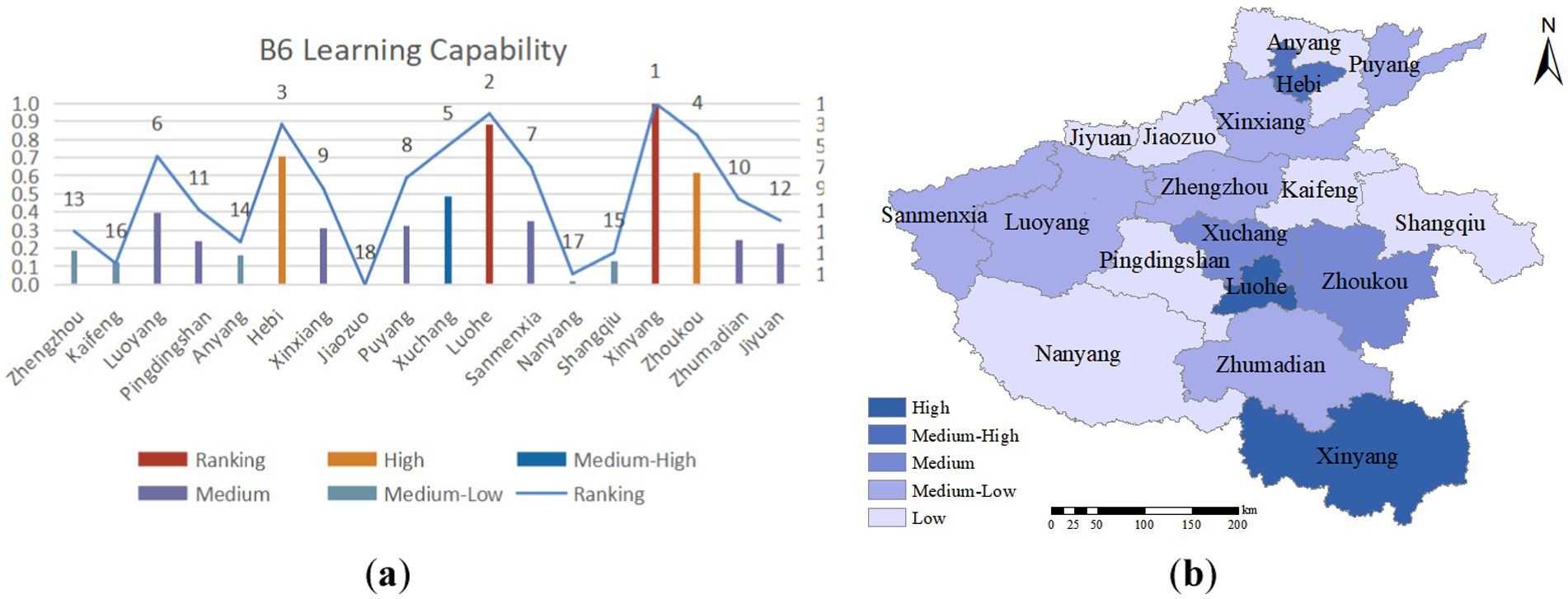
Figure 9. (A) Learning capability evaluation value and ranking; (B) learning capability assessment distribution.
5 Conclusion and suggestion
Drawing on the integration of the whole-process equilibrium theory and emergency management theory, this study presents an evaluation model for the emergency management capability of urban public health emergencies. The model comprises 31 indicators across six dimensions and is validated using data from 18 cities in Henan Province. The evaluation results reveal that Jiaozuo, Hebi, Zhengzhou, and Luohe exhibit high overall emergency management capability, while Kaifeng, Pingdingshan, and Shangqiu demonstrate relatively low capability. Furthermore, the northern region of Henan displays more robust emergency preparedness and early warning capabilities, whereas the central region exhibits more vital emergency mitigation and recovery capabilities. The study also finds that the emergency management capability of urban public health emergencies is closely linked to the frequency of disaster prevention and mitigation training, the proportion of financial investment in disaster prevention and emergency management, and the investment in medical resources. These conclusions provide a qualitative basis for the long-term layout of government emergency management in the later period. Based on these findings, the study proposes several strategies to enhance the emergency management capability of urban public health emergencies:
(1) Consolidate the legal review mechanism of public health emergency, and lay the legal foundation for improving the government’s emergency management ability (34). The legislature should fully implement the concepts of “big hygiene” and “big health,” firmly establish the basic idea of “constant change and constant innovation,” establish an efficient legal review mechanism, and ensure that public health laws keep up with the development trend of public health. Therefore, the disease control agencies and health professionals should learn the frontier knowledge in the field of social public health in real time, and review the professional knowledge related to the law of public health emergencies in a timely manner, and establish inter-departmental coordination mechanism, in order to review the law in a coordinated manner, to avoid conflicts or inconsistencies between different systems.
(2) Improve the planning of emergency medical facilities and enhance the reserve force of the government’s emergency preparedness capacity. The space reservation planning of emergency medical facilities can ensure that sufficient space and equipment are prepared for later emergency disposal in the event of damage or large-scale medical assistance. For example, the ‘shelter hospital’ during the COVID-19 epidemic has the advantages of short construction time, large capacity, low construction cost and high treatment efficiency. Emergency medical facilities can provide alternative locations in crisis situations. Therefore, cities should strengthen risk assessment in land use planning according to the characteristics of local natural and social environment, and maintain the accessibility of resources such as transportation, electricity, communication and water to meet the emergency needs of severe public health emergencies.
(3) Establish a diverse collaborative network to attract participation from all sectors of society. The remarkable achievements in epidemic prevention and control in China since the outbreak of COVID-19 are attributed to the governance concept of Party and government leadership, which relies on administrative power to coordinate the interests of residents, enterprises, and social organizations and construct an emergency management mechanism with multi-party participation (35). Therefore, to fully mobilize the participation of social organizations, the Red Cross, volunteer organizations, and news media, a diverse collaborative network should be established based on the development characteristics of each city and the local emergency management situation. This network should leverage different entities’ technical and professional advantages, enhancing the scientific and professional level of urban emergency management.
(5) Establish a smooth, sensitive information management system and strengthen public opinion guidance and supervision. Following the relevant policies of the state on big data, the government should solve the problem of information silos, ensuring the maximization of data value while also being vigilant against the leakage of private health information and its unauthorized use for commercial purposes. The government should guide public opinion to prevent the spread of false information and avoid amplifying people’s panic. A scientific system for public opinion management assessment and accountability should be established, and relevant management personnel should be held accountable for uncontrollable public opinion incidents.
(6) Based on reality, attach importance to post-disaster emergency management capacity assessment and learning. Cities should regard emergency management assessment as an essential indicator for evaluating grassroots administrative units. A system and mechanism for assessing and evaluating the prevention of sudden public health incidents that serve residents should be established, ensuring that every aspect of the prevention and control task of sudden public health incidents is traceable. After sudden public health incidents, the crisis should be transformed into an opportunity for development. Shortcomings exposed in the process of emergency rescue and control should be summarized and improved promptly, and multiple solutions should be proposed for various problems to prevent the recurrence of similar problems.
Data availability statement
The original contributions presented in the study are included in the article/supplementary material, further inquiries can be directed to the corresponding author.
Author contributions
YH: Conceptualization, Formal analysis, Funding acquisition, Methodology, Project administration, Resources, Supervision, Validation, Writing – review & editing. YT: Data curation, Formal analysis, Investigation, Methodology, Project administration, Software, Validation, Visualization, Writing – original draft, Writing – review & editing. LZ: Conceptualization, Methodology, Supervision, Validation, Writing - review & editing. FZ: Methodology, Project administration, Software, Supervision, Validation, Writing – review & editing. CS: Conceptualization, Funding acquisition, Project administration, Resources, Supervision, Validation, Writing – review & editing.
Funding
The author(s) declare financial support was received for the research, authorship, and/or publication of this article. This research is funded by the National Natural Science Foundation of China (NSFC)(52374196); Humanities and Social Sciences Foundation of Henan Polytechnic University (SKY2021-01); Philosophy and Social Science Innovation Team of Henan Province (2023-CXTD-06); Research Foundation of Humanities & Social of Henan Polytechnic University (SKJO2020-01).
Conflict of interest
The authors declare that the research was conducted in the absence of any commercial or financial relationships that could be construed as a potential conflict of interest.
Publisher’s note
All claims expressed in this article are solely those of the authors and do not necessarily represent those of their affiliated organizations, or those of the publisher, the editors and the reviewers. Any product that may be evaluated in this article, or claim that may be made by its manufacturer, is not guaranteed or endorsed by the publisher.
References
1. Chan, JF, Yuan, S, Kok, KH, To, KKW, Chu, H, Yang, J, et al. A familial cluster of pneumonia associated with the 2019 novel coronavirus indicating person-to-person transmission: a study of a family cluster. Lancet. (2020) 395:514–23. doi: 10.1016/S0140-6736(20)30154-9
2. David, ND, Laurence, OG, and Keymanthri, M. When does a major outbreak become a public health emergency of international concern? Lancet Infect Dis. (2020) 20:887–9. doi: 10.1016/S1473-3099(20)30401-1
3. Sarkodie, SA, and Owusu, PA. Global assessment of environment, health and economic impact of the novel coronavirus (COVID-19). Environ Dev Sustain. (2021) 23:5005–15. doi: 10.1007/s10668-020-00801-2
4. Xinhuanet. (2020). Xi Jinping: Speech at the national recognition meeting for the fight against Covid-19. Available at: http://www.xinhuanet.com/politics/2020-10/15/c_1126614978.htm (Accessed October 15,2020).
5. Guo, YS. Capacity of national civil servants to respond to emergencies. Beijing: China Social Sciences Press (2005).
6. Xu, M, and Xu, D. Study on the impact of emergency management capability on the quality of prevention and control of public health emergencies-based on 31 provincial panel data analysis. J Macro-qual Res. (2023) 11:95–104. doi: 10.13948/j.cnki.hgzlyj.2023.03.007
7. Zheng, L, Zhang, ZL, and Shui, Y. Research on the resilience construction of megacity community based on public health emergencies—taking Chengdu as an example. Chin J Public Health Man. (2024). 4:487–91. doi: 10.19568/j.cnki.23-1318.2024.04.0005
8. Zhang, HB. The full process balance of emergency management. Chinese Public Adm. (2020) 417:123–30. doi: 10.19735/j.issn.1006-0863.2020.03.20
9. Eleftherios, S, Demetrios, M, Antonios, A, Dimitrios, D, and Periklis, T. Facing the unexpected: Chest Wall swelling 7 years after a stab injury. J Emerg Med. (2016) 50:e33–5. doi: 10.1016/j.jemermed.2015.06.023
10. Waugh, WL. Living with hazards, dealing with disasters: An introduction to emergency management. New York: M.E. Sharpe (2020).
11. Leslie, M. Enhancing post-disaster resilience by ‘building back greener’: evaluating the contribution of nature-based solutions to recovery planning in Futaba County, Fukushima prefecture, Japan. Landsc Urban Plan. (2019) 187:105–18. doi: 10.1016/j.landurbplan.2019.03.013
12. Miguel, OB, and Juan-Jose, AS. A hybrid fuzzy multi-criteria decision-making model to evaluate the overall performance of public emergency departments: a case study. Int J Inf Technol Decis Mak. (2020) 19:1485–548. doi: 10.1142/S0219622020500364
13. Ma, GF, Tan, S, and Shang, SS. The evaluation of building fire emergency response capability based on the CMM. Int J Environ Res Public Health. (2019) 16:1962. doi: 10.3390/ijerph16111962
14. Purba, D, and Suwondo, I. Analysis of search and rescue emergency evaluation in ship accidents in Indonesia. SHS Web Conf. (2018) 42:119. doi: 10.1051/shsconf/20184200119
15. Cheng, FM, Wang, CC, and Yuan, XF. Evaluation of urban emergency management capabilities from perspective of safe development. China Saf Sci J. (2023) 33:158–67. doi: 10.16265/j.cnki.issn1003-3033.2023.05.2014
16. Chuai, XM, Du, LL, and Qu, YC. Evaluation of urban disaster emergency capability based on the full process balance theory of emergency management. Resour Dev Mark. (2023) 39:385–91. doi: 10.3969/j.issn.1005-8141.2023.04.001
17. Jia, J, Dou, SY, Fan, GX, and Wang, CX. Research on the evaluation for earthquake emergency response capacityof islands based on entropy weight theory and grey relational analysis. World Earthquake Eng. (2020) 36:233–41. doi: 10.3969/j.issn.1007-6069.2020.03.024
18. Ming, XN, Chen, Q, Zhou, Y, and Lu, YK. Yunnan earthquake emergency preparedness capacity evaluation index and calculation of local government. J Seismol Res. (2018) 41:132–8.
19. Liu, J, Su, GW, Sun, JN, Song, LJ, Deng, Y, Qi, WH, et al. A preliminary study on the index system for earthquake EmergencyResponse ability and regional differences of Xinjiang counties. Technol Earthq Disaster Prev. (2016) 11:814–22. doi: 10.11899/zzfy20160412
20. Huang, YM, Hu, XM, Huang, TL, and Yu, G. Construction and analysis of evaluation system for earthquake emergency response capacity of counties in Guangdong Province. South China J Seismol. (2015) 35:59–65. doi: 10.13512/j.hndz.2015.04.09
21. Wu, C, Cenci, J, Wang, W, and Zhang, J. Resilient city: characterization, challenges and outlooks. Buildings. (2022) 12:516. doi: 10.3390/buildings12050516
22. Zhu, ZW, Zhao, Y, and Ma, H. From Resilient City to resilient Safe City: the practice and logic of improving urban resilience in China. Nanjing J Soc Sci. (2024) 07:53–65+77. doi: 10.15937/j.cnki.issn1001-8263.2024.07.006
23. Wang, HQ, Ye, H, Liu, L, and Li, JX. Evaluation and obstacle analysis of emergency response capability in China. Int J Environ Res Public Health. (2022) 19:10200. doi: 10.3390/ijerph191610200
24. An, M, Liu, MF, and An, H. Thomas Stephen Ramsey, systematic evaluation of emergency management capacity for rural public health emergencies. Int J Disast Risk Re. (2023) 85:103493–4209. doi: 10.1016/j.ijdrr.2022.103493
25. Wang, K, Wang, Z, Deng, J, Feng, YY, and Li, QF. Study on the evaluation of emergency management capacity of resilient communities by the AHP-TOPSIS method. Int J Environ Res Public Health. (2022) 19:16201. doi: 10.3390/ijerph192316201
26. Yang, FF, Zhang, JF, Jin, BX, Wang, SY, and Xi, CX. Study on the emergency capacity of coal mine enterprises in Longdong area based on D-FAHP method. Sci Rep. (2023) 13:7503. doi: 10.1038/s41598-023-34618-6
27. Talisuna, A, Yahaya, AA, Rajatonirina, SC, Stephen, M, Oke, A, Mpairwe, A, et al. Joint external evaluation of the international health regulation capacities: current status and lessons learnt in the WHO African region. BMJ Glob Health. (2019) 4:001312. doi: 10.1136/bmjgh-2018-001312
28. Shen, J, Ma, XX, and Qiao, WL. A model to evaluate the effectiveness of the maritime shipping risk mitigation system by entropy-based capability degradation analysis. Int J Environ Res Public Health. (2022) 19:9338. doi: 10.3390/ijerph19159338
29. Keita, M, Talisuna, A, Chamla, D, Burmen, B, Cherif, MS, Polonsky, JA, et al. Investing in preparedness for rapid detection and control of epidemics: analysis of health system reforms and their effect on 2021 Ebola virus disease epidemic response in Guinea. BMJ Glob Health. (2023) 8:010984:e010984. doi: 10.1136/bmjgh-2022-010984
30. Rivera, L, Pagaoa, M, Morgenthau, BM, Paquet, C, Molinari, NAM, and LeBlanc, TT. Participation in community preparedness programs in human services organizations and faith-based organizations—new York City, 2018. Morb Mortal Wkly Rep. (2019) 68:757–61. doi: 10.15585/mmwr.mm6835a2
31. Liu, Y, Eckert, CM, and Earl, C. A review of fuzzy AHP methods for decision-making with subjective judgements. Expert Syst Appl. (2020) 161:113738. doi: 10.1016/j.eswa.2020.113738
32. Zuo, C, Wang, W, Qi, Y, and Cui, XC. Evaluation of coal mine emergency management ability based on entropy weight method and BP neural network. J Shanxi Datong Univ. (2024). 5:116–20. doi: 10.3969/j.issn.1674-0874.2024.02.022
33. Liu, JK, Wang, JR, and Wang, CX. Emergency capability evaluation of subway station under improved combination weighting-cloud model. J Safety Environ. (2023) 23:1398–406. doi: 10.13637/j.issn.1009-6094.2022.1985
34. Peng, X. Emergency legal mechanism of humanitarian logistics in public health emergencies. China Bus Mark. (2020) 34:35–42. doi: 10.14089/j.cnki.cn11-3664/f.2020.03.005
Keywords: public health emergencies, the full process balance of emergency management, emergency management capacity, capacity evaluation, TOPSIS model
Citation: Hao Y, Tie Y, Zhang L, Zhang F and Sun C (2024) Research on the evaluation of emergency management capability for urban public health emergencies under the perspective of resilience—a case study of Henan Province, China. Front. Public Health. 12:1431158. doi: 10.3389/fpubh.2024.1431158
Edited by:
Lara Salahi, Endicott College, United StatesReviewed by:
Thomas Ramsey, China Three Gorges University, ChinaVictoria Ramos Gonzalez, Carlos III Health Institute (ISCIII), Spain
Copyright © 2024 Hao, Tie, Zhang, Zhang and Sun. This is an open-access article distributed under the terms of the Creative Commons Attribution License (CC BY). The use, distribution or reproduction in other forums is permitted, provided the original author(s) and the copyright owner(s) are credited and that the original publication in this journal is cited, in accordance with accepted academic practice. No use, distribution or reproduction is permitted which does not comply with these terms.
*Correspondence: Chaolun Sun, U3VuY2xAaHB1LmVkdS5jbg==
 Yu Hao1,2
Yu Hao1,2 Yuxin Tie
Yuxin Tie Lijun Zhang
Lijun Zhang Fan Zhang
Fan Zhang Chaolun Sun
Chaolun Sun
